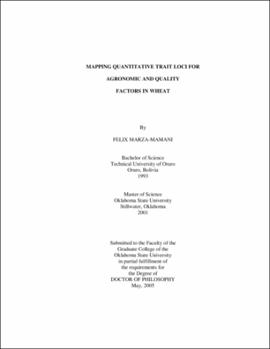| dc.contributor.advisor | Carver, Brett F. | |
| dc.contributor.author | Marza-Mamani, Felix | |
| dc.date.accessioned | 2013-12-10T18:04:36Z | |
| dc.date.available | 2013-12-10T18:04:36Z | |
| dc.date.issued | 2005-05 | |
| dc.identifier.uri | https://hdl.handle.net/11244/7737 | |
| dc.description.abstract | Scope and Methods of Study: Agronomic and quality traits are important factors in wheat (Triticum aestivum L.) improvement and in determining end-use product value. Knowledge regarding the number, genomic location, and effect of quantitative trait loci (QTL) would facilitate marker-assisted selection and the development of cultivars with desired trait complexes. Our objectives were to identify QTLs influencing agronomic and milling performance, and to determine their genetic effects. A population of 132 F12 recombinant inbred lines (RILs) was derived by single-seed descent from a cross between the Chinese facultative wheat, Ning7840, and the U.S. soft red winter wheat, Clark. The population was grown at three Oklahoma locations from 2001 to 2003. Measurements were collected for yield, yield components, plant adaptation, spike morphology, kernel size, and class factors. | |
| dc.description.abstract | Findings and Conclusions: Twenty-nine linkage groups, consisting of 363 AFLP and 47 SSR markers, were identified. Using composite interval mapping (CIM) analysis, 10, 16, 30, and 14 QTLs were detected for yield, yield components, plant adaptation, and spike morphology traits, respectively. Alleles from Clark were associated with a positive effect for the majority of QTLs for yield and yield components. Consistent, co-localized QTLs for yield and yield components were identified in linkage groups 1AL, 1B, 4B, 5A, 6A, and 7A, and less consistent but unique QTLs were found on 2BL, 2BS, 2DL, and 6B. For quality traits, a unique QTL was identified for test weight in linkage group 5B, presumably influencing grain packing efficiency. Common markers were identified for test weight, kernel weight, and kernel diameter on 5A. Consistent co-localized QTLs were identified for kernel weight and kernel diameter in linkage group 6A. Important QTLs with strictly additive effects were identified in linkage groups 5A (yield), 5A, 2BS (test weight), and 5B (kernel weight) through mixed-model QTL analysis. Epistatic QTLs tended to show a greater level of QTL x environment interaction than additive QTLs, suggesting that epistatic QTLs are more prone to environmental influence than additive QTLs. Results of this study provide a benchmark for future efforts on QTL identification. | |
| dc.format | application/pdf | |
| dc.language | en_US | |
| dc.rights | Copyright is held by the author who has granted the Oklahoma State University Library the non-exclusive right to share this material in its institutional repository. Contact Digital Library Services at lib-dls@okstate.edu or 405-744-9161 for the permission policy on the use, reproduction or distribution of this material. | |
| dc.title | Mapping quantitative trait loci for agronomic and quality factors in wheat | |
| dc.contributor.committeeMember | Klatt, Arthur | |
| dc.contributor.committeeMember | Shaver, Jonathan | |
| dc.contributor.committeeMember | Bai, Guihua | |
| osu.filename | Marza-Mamani_okstate_0664D_1248.pdf | |
| osu.accesstype | Open Access | |
| dc.type.genre | Dissertation | |
| dc.type.material | Text | |
| dc.subject.keywords | wheat | |
| dc.subject.keywords | qtl | |
| dc.subject.keywords | yield | |
| dc.subject.keywords | plant adaptation | |
| dc.subject.keywords | spike morphology | |
| dc.subject.keywords | ssr | |
| dc.subject.keywords | aflp | |
| thesis.degree.discipline | Crop Science | |
| thesis.degree.grantor | Oklahoma State University | |
